Customer experience once felt like the most personalized approach marketers could take.
Today, it feels out of touch. A year in which a global pandemic and civil unrest forced murder hornets and UFO sightings to page 2 of the news will do that.
A New Approach – Human Experience
As the COVID-19 disruption eventually eases, brands will move into an age in which consumer engagement is about more than demographics and spending power. Sensitivities developed in tough times have left the standard of care that empowers humans first.
HX, the human experience, has arrived to replace CX – the customer experience.
“We have to enter into a conversation focused on understanding where they are,” said Andy Kovan, Vice President and Director of Strategy and Research at The Brandon Agency. “It’s recognizing the playing field has changed significantly and learning what we can do as a brand to help them.”
Worldwide Partners teamed with GlobalWebIndex, a market research SaaS company that provides audience insight to marketers, media agencies, and publishers worldwide, to examine this new marketing model for the new normal.
Both focus on the consumer – but HX goes further to meet shifting expectations.
| Customer experience | Human experience |
| Identifies you | Understands you |
| Delivers satisfying transaction | Enables a more fulfilling life |
| Intercepts people with reasons to believe and ways to buy | Provides a continuum of engagement that improves people’s lives |
Why Brands Need a Human Touch
Tech angst refers to the conundrum of being reliant on technology to live, work, and play – yet plagued by the idea of excessive screen time.
Brands risk alienating audiences if they don’t recognize this pain point. It won’t matter how stellar products and brand values are, or how clever and spot-on messaging is. To be tone-deaf to the human condition in marketing is to be irrelevant in the marketplace. To stay pertinent, brands must shift the focus to treating the customer as human, not just a target.
“It’s about the approach, having an empathetic ear to adjust messaging,” Kovan said. “We can shift that conversation. In social media, it’s a more relevant realization of how we can, what we can do. The ‘all in this together approach,’ is used so much, but there’s a way to humanize that. For telecommunications clients, the ability to provide services at a discount appeals to customers. Kids need the internet for school. People working from home need it, too.”
Screens Are Everywhere
High-tech is more pervasive than premium. As a fundamental element to gain mass appeal, screens can reach every generation and demographic. Regardless of the size of a brand’s digital footprint, human-first messaging is critical to forge a brand relationship.
“You must understand where they are,” Kovan said. “It’s through little insights from research, through monitoring human behavior, understanding people’s motivations. How closely are you paying attention? If you capture insights, you still have to turn them into actionable data points.”
Adding to that broad visibility: tech angst again. The contradiction of wanting constant connection while also looking to distance from it is an obstacle for brands.
Methods that were thought to spur consumer engagement now have become a part of the problem. Download this app, add that plugin. Opt-in for our newsletter, and please like us and share our content!
It takes a mindful approach to improve on that, Kovan said.
“A lot of clients needed just a little bit of a shift,” Kovan said. “We have seen growth in a time when we shouldn’t be having growth. It’s sometimes hard to quantify, but we definitely have seen success with simple tweaks to the approach and messaging.”
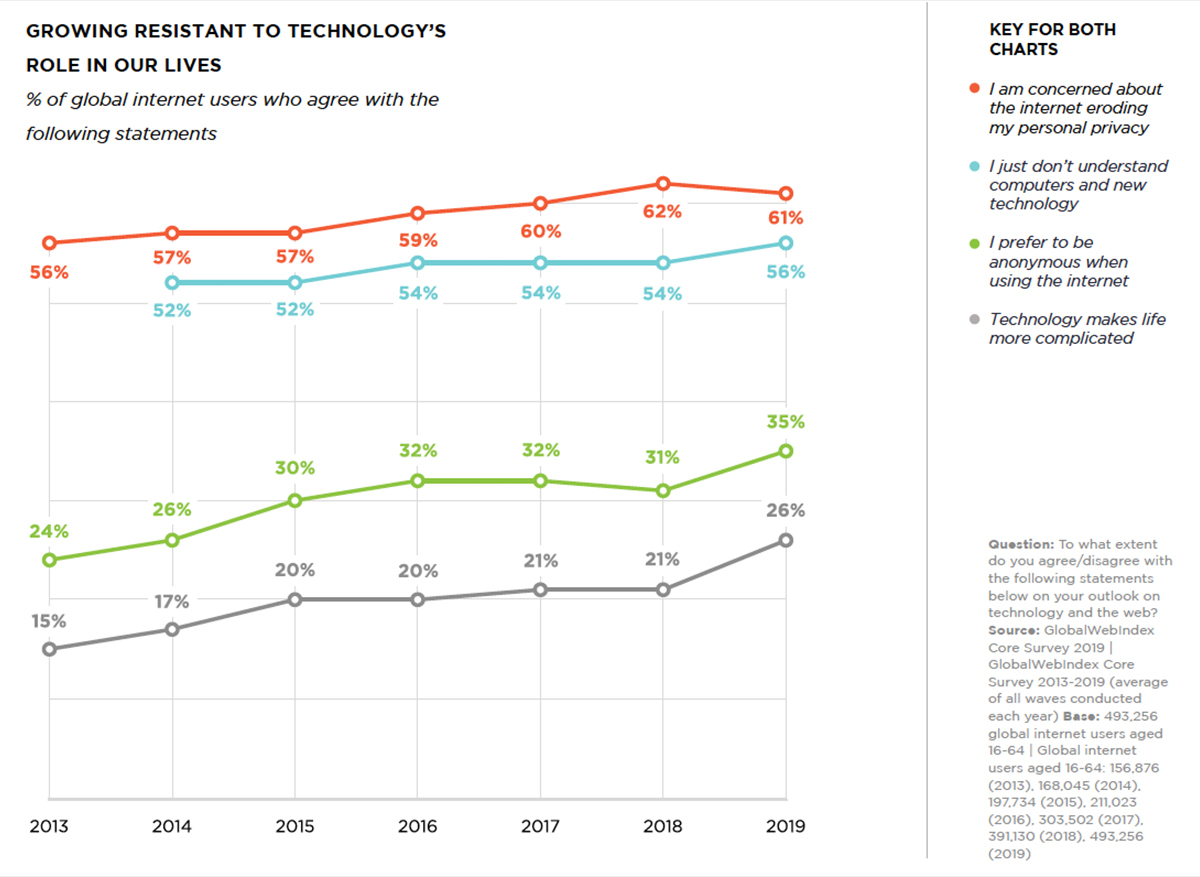
One thing the COVID-19 pandemic proved: Tech can only go so far. Rather than wish we could laze around scrolling through our social feeds, we craved human-based experiences when human-based experiences were difficult. In the height of the lockdown, this joint study revealed that 94% of consumers in 17 global markets said they spent more time on connected devices.
That’s since leveled off.
People are spending more time in the kitchen, reading, going outside. That’s a plot twist for brands to build consumer engagement post-crisis. Reorienting human-first experiences and messaging is critical to meet consumer expectations.
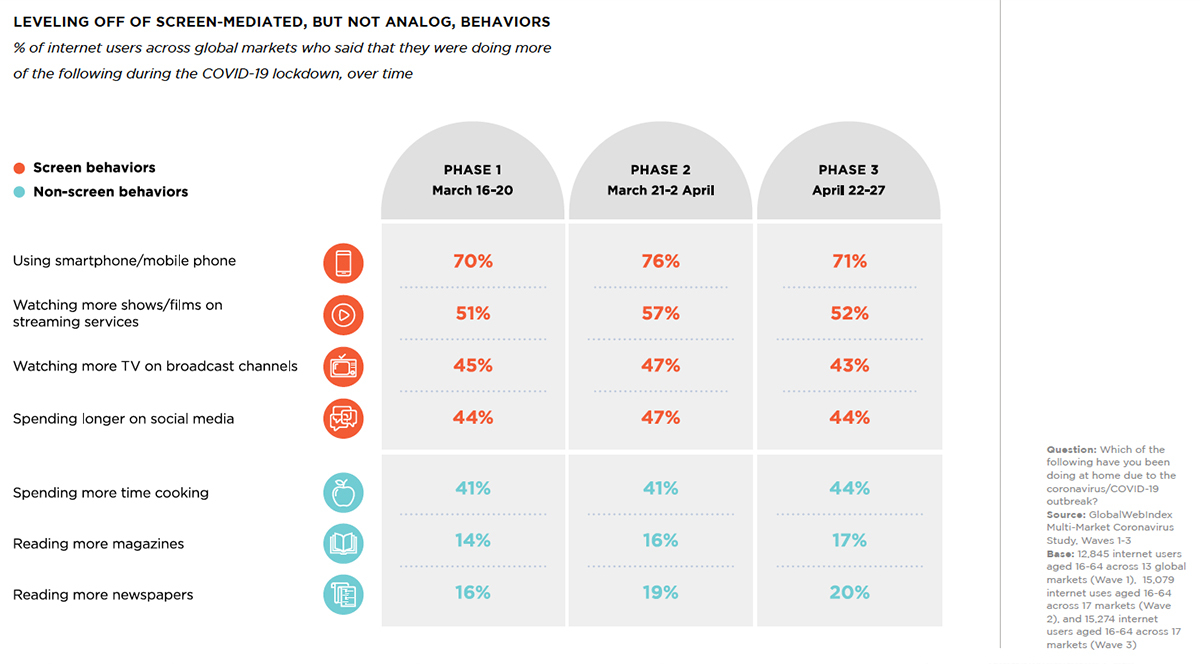
HX in Healthcare
In a post-pandemic world, how will patients accept the permanence of health tech – and how can facilities make that feel human?
Health tech, especially telehealth, burst onto the scene when the industry needed it most. Consumers are cautious with other forms of health tech. Health and fitness app adoption has doubled since 2012, but that growth lags behind other types: at one-third of shopping apps, and 65% lower than banking apps.
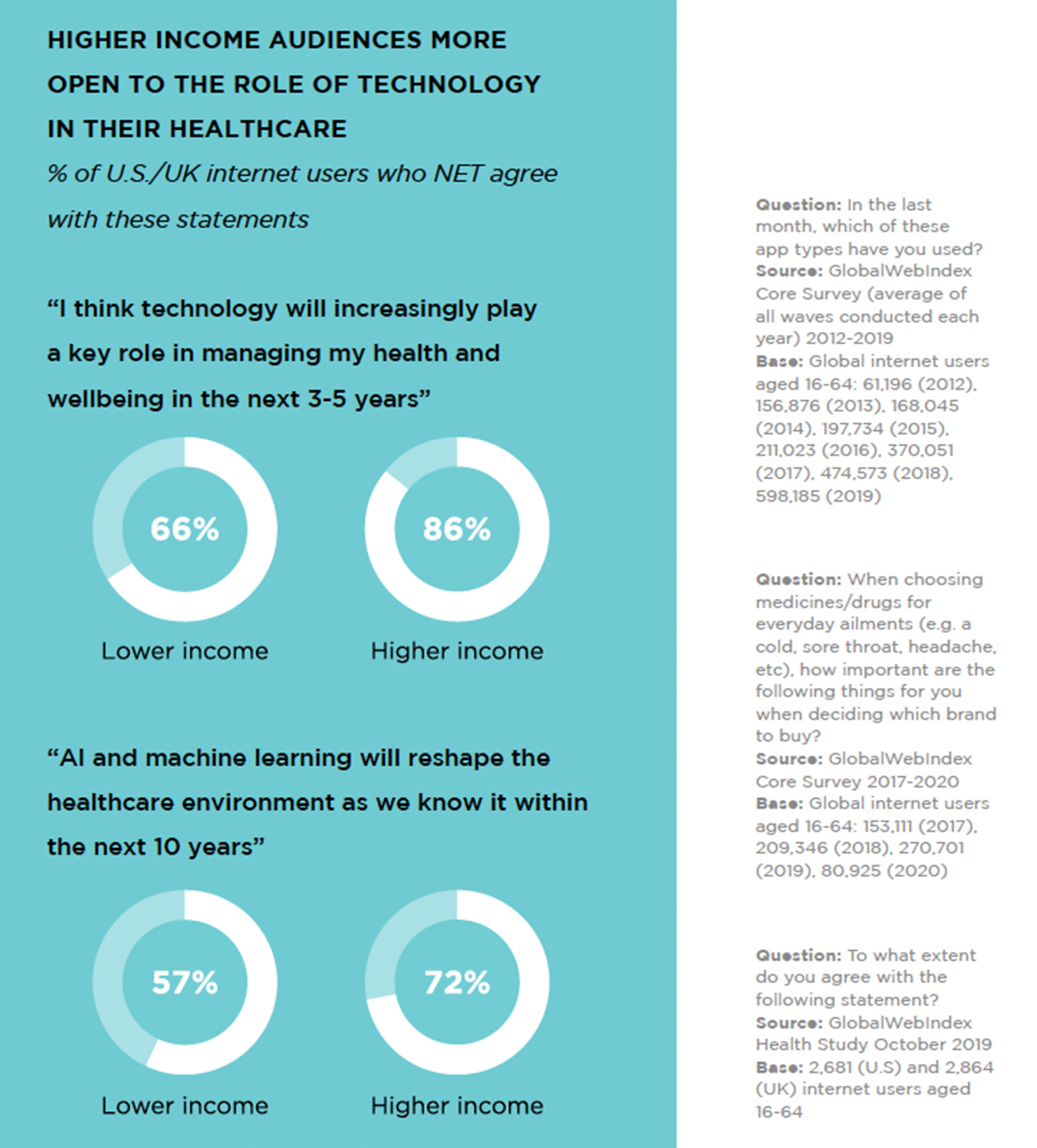
COVID-19 forced many patients with pre-existing conditions out of in-person visits.
“Now, health brands must quickly re-activate these patient populations to engage again by acknowledging their altruism and endorsing the legitimacy of their very real and human health needs,” said Andrew Bast, Chief Strategy Officer of Greater Than One, a creative agency in New York.
Coronavirus pushed digital health from optional to critical. Post-pandemic, it stands to change the game even after social distancing dissipates.
Before COVID-19, 16% of respondents in the U.S. and U.K. had experienced telehealth. As the lockdown ramped up, that leapt to 45%. Overall, 53% said they’d consider telehealth for coronavirus screenings. This is a huge opportunity to create a human experience to encourage those open to telehealth to try it – and for at-risk populations to believe they’re still being taken care of.
Although some are open to a mix of in-person and telehealthcare, others place a premium on the human touch – and have corresponding leeriness about health tech.
Consider that nearly one-third of those in the U.S. and U.K. say they felt rushed at doctors’ appointments, and 25% are dissatisfied with the attention they get in those visits. Just as other forms of health tech move ahead at a cautious pace, so too does the acceptance of telehealth as a replacement for the office visit.

Those wary of impersonal healthcare aren’t likely to favor artificial intelligence in the marketplace, either. Concerns include questions of quality, interaction, accuracy, and the ability of staff to operate AI.
Sofie Svarre is Partner and Director of Insights & Strategy for Advance Partners, a B2B service based in Ohio affiliated with Worldwide Partners in Denmark. She acknowledges the stress of navigating the lockdown for patients.
“Finding ways of helping chronic patients deal with this mental burden without having to leave their homes are challenging but important, a task that both HCPs and healthcare companies can engage in to truly show that they are connected with their users beyond just the medical condition,” Svarre said.
Key Takeaways
- Tech in the back, human interaction in the front. Tech can streamline impersonal duties – data entry, paperwork, etc. – to afford more face-to-face time with patients.
- Be detail-oriented. Human experience revolves around peoples’ specific stories – and it’s the little details that create the big picture of their healthcare.
- Make voices central to the experience. Have the conversations to ensure patients that tech is a supplement to their care, not a replacement.
HX in Consumer Packaged Goods and Retail
CPG brands sometimes struggle with customer connection. Product manufacturing, distribution, and purchase can be impersonal. Brand storytelling, production and purchase touch-points provide an opportunity for CPG brands to differentiate themselves.
Community plays a role, Kovan said, in finding common ground between brand and consumer.
“I love the word community, beyond what it means to be a neighbor,” Kovan said. “We’re tied together through human experience and traditions. It’s cool to see people come together, set aside different ideologies, and focus on what we have in common.”
From 2012 to 2020, consumers who said they’d patronize a business to become part of the community built around it rose by 36%. They value transparency and the human story behind the business.
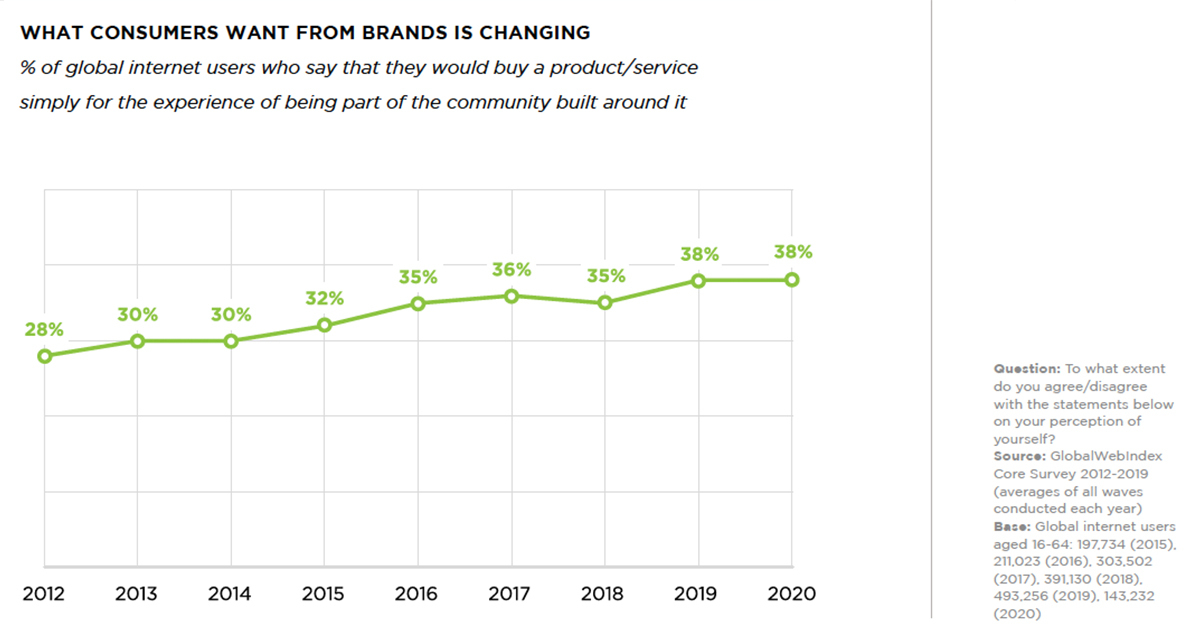
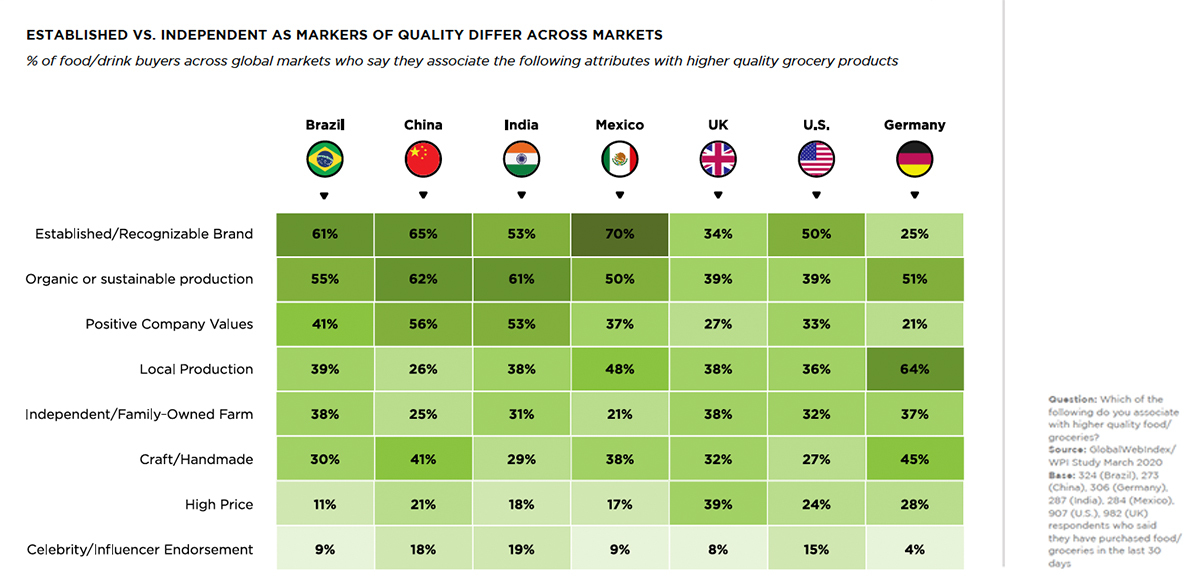
Especially in commonalities, like wanting some normalcy to an abnormal way of life.
“We see it in our apparel lines,” Kovan said. “We all want to have our routine, to feel normal, to just put on a nice shirt. We’re humans.”
What influence do labels such as craft or homemade have on the consumer?
Those usually identify products as unique, not mass-produced, and of high quality. Studies show a greater value on these attributes in mature markets over emerging ones. Consumers in China, India, and the U.K. prefer established brands to craft/homemade (60%). In Germany, handmade is considered better. In the U.S., 54% favor craft/homemade products.
Human Interaction Is Necessary Online
It’s possible to traverse the purchase journey without encountering another human being. In-store self-checkouts and online shopping with next-day delivery will do that.
As it is in social media advertising, technology becomes both bridge and barrier between CPG brands and their customers. This is where the human experience comes in.
Mature markets, such as China (66%) and India (59%) prefer human interaction; Asia-Pacific and other emerging markets love the tap-swipe-buy-delivered method. Surprisingly, 80% of personal care buyers in the U.S., U.K., and Germany wants the human experience. This is a chance to rethink business, says Vitor Barros, CEO of Propeg Advertising in Brazil.
“The proximity and human experience of the physical retail environment has to merge with the rapidly accelerating consumer pivot to online shopping,” he said.
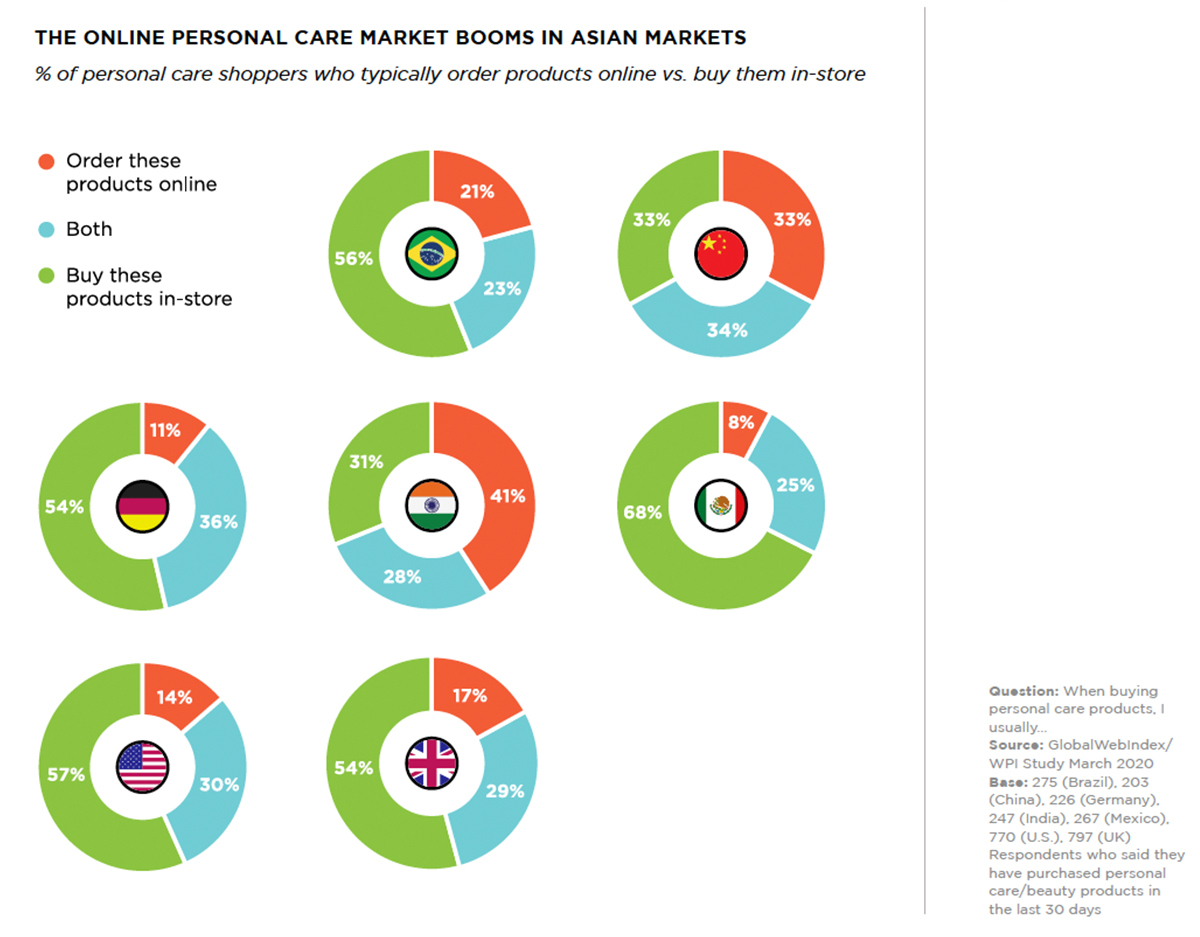
Consumers want the human touch in various stages of buying: Advice, personalized service, and recommendations included. Key to those points: personal relationships with the brand and great customer care.
Key Takeaways
- Imperfect origin stories are still valued. People want real, not real polished. A human face and journey story separates a brand in the masses. Struggles are part of the appeal – who doesn’t love an underdog?
- Actual humans are the value. Automation is convenient, but the best product experience includes human-to-human touch-points. Consumers have questions and need to know the story behind a product or its brand. If they get that, they probably won’t mind paying more – and likely won’t comparison-shop.
- Know your market. Established brands have acquired trust, but need those powerful forces that demonstrate they’re invested in quality products and the communities they operate in.
HX inTravel and Tourism
The downturn hit this industry viciously.
Human experience strategy can help brands achieve benefits. This can be implemented by:
- Adopting ‘back to basics’ experiences
- Providing opportunities to craft unique experiences
- Furnishing digital activations and a chance to bypass tech angst
Native people to travel destinations have always factored into travel, says Fuse Create director of customer experience Lanny Geffen.
“The physical attributes of a place are how it can stand out, but how the locals made us feel is what sticks long after we have left,” Geffen said. “Get ready to see this human attribute lead the brand narrative for even more countries.”
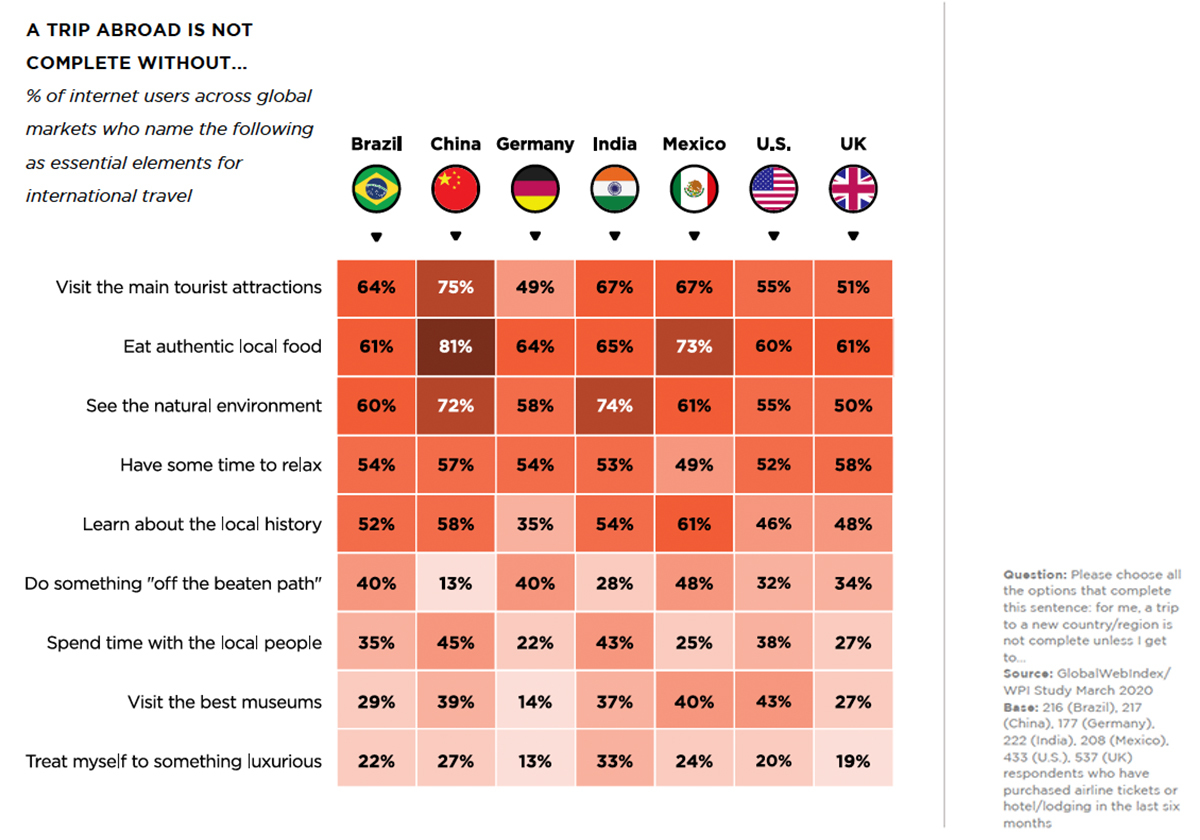
Travel isn’t the only vertical resounding with consumers with a “back to basics” approach. But it has a unique history. Human aspects of travel – local environment, food, and people – were an allure to globetrot way before commercial tourism.
How important is it to visit local attractions when vacationing? Travelers from Brazil, China, India, and Mexico are more likely than those from the U.S., U.K., and Germany to place a premium on tourists attractions. China leads the way at 53%.
Central to the idea of the human experience is the path less traveled.
Travelers want the freedom to plot their own way, and for some, that’s off the beaten path. That route isn’t as appealing to travelers from China and India. Worldwide, higher income travelers are more likely to want an adventure on their getaway – likely because they can best afford one.

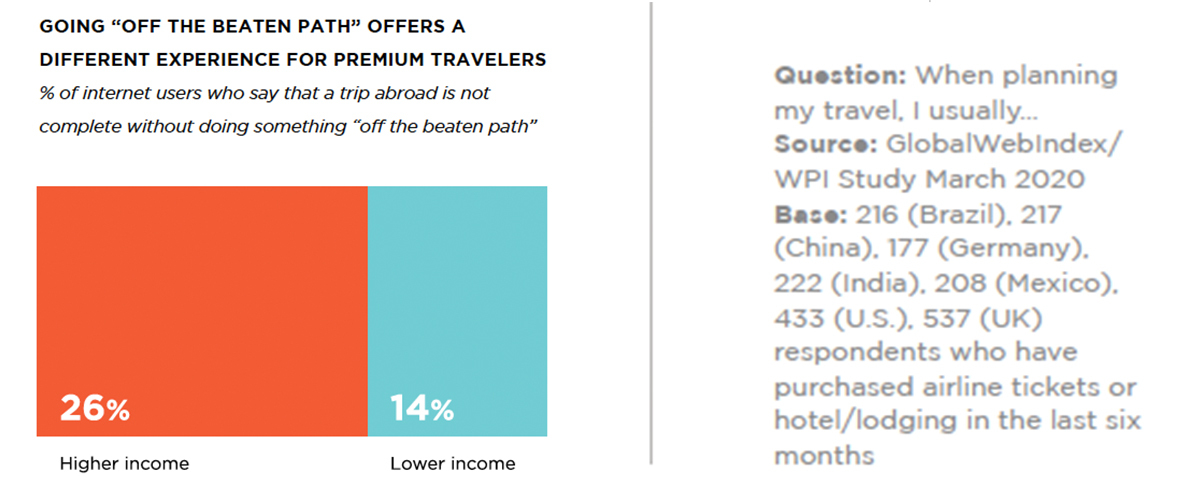
Travel has another draw that has gained value: the chance to disconnect.
Who wouldn’t want a pause in life to reset, minus alerts and pings? It’s attractive to travels, but not always feasible, especially among travelers in high income groups and emerging markets.
Plus, how would travelers post their vacation pics on Instagram without tech? It’s a battle of FOMO (fear of missing out) vs. true detox. Mature-market travelers want to turn off social media when they get away. Expect posts and updates from those in emerging markets, for which travel and social sharing go hand-in-hand. Travelers from Brazil and India are unlikely to unplug, the study showed.
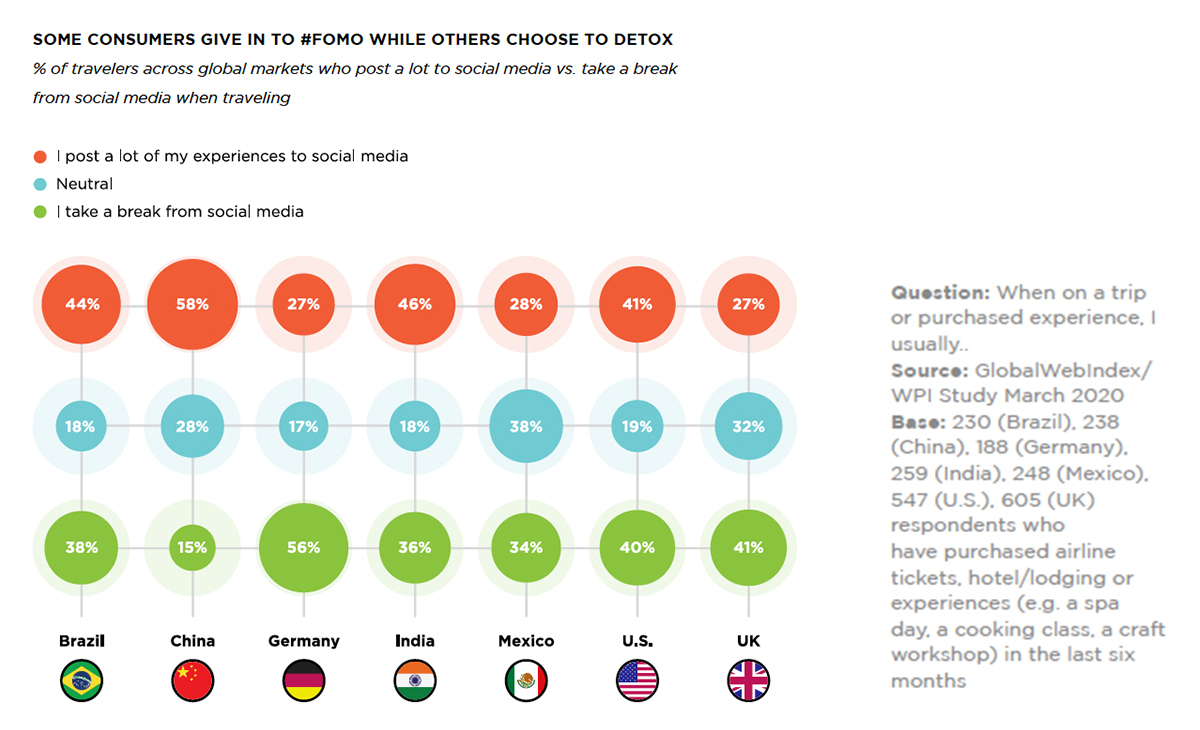
Key Takeaways
- Let culture tell the story. Tech has widened the scope of how much of the world we can see from our couch. What can you offer that can bind the traveler to the destination on an emotional level?
- Allow the ability to chart a course. Higher income and mature market travelers want adventure with their experience.This plays into the idea of human experience – a unique vacation the traveler crafts.
- Safety is the human touch. The quickest way to carefree travel: Safety, in practice and in marketing. Contactless ticketing, increase sanitation, and quick updates help increase the humanization of travel.
HX in Business to Business
Just as consumers crave connection and engagement, so too do businesses. The same principles of business-to-customer marketing could emerge universally. Those who implement it sooner than later stand to gain an advantage in the marketplace.
Business owners are people, too. So it stands to reason they’d be subject to the same social phenomena discussed here, including tech angst.
“There are definitely tangible things happening in the marketplace,” Koan said. “All along, we’ve reacted to the life going on around us. Understanding what people are going through can help to make life more normal than what it might have been.”
Most of us can relate: 58% of people in 10 global markets who are on video calls hourly agree with the statement: “technology makes life more complicated.” Professionals whose videoconferencing happens a few times a day are 44% more likely to agree. Once-a-day users? Their percentage is 38%.
The more you’re connected for work – and many people are connected way more than before – the more you don’t want to be.
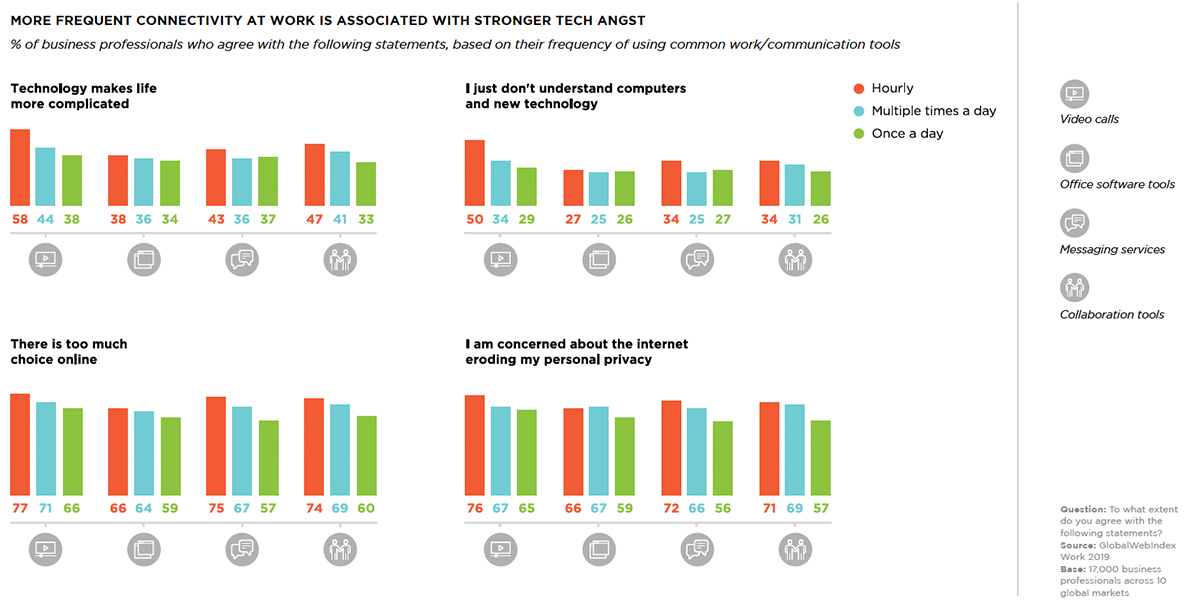
Decision makers, as do most consumers right now, respond well to brands that exude a human side. The closer you are to the position that makes the call on budgets, the more likely you are to want a partnership with a company you have a one-to-one connection with. For office staff, it’s 17%, managers and supervisors 19%, and executives and management, 23%.
The more tech-immersed a professional is, the greater likelihood they’re seeking that human element, too. This goes for large enterprise business and innovative companies especially.
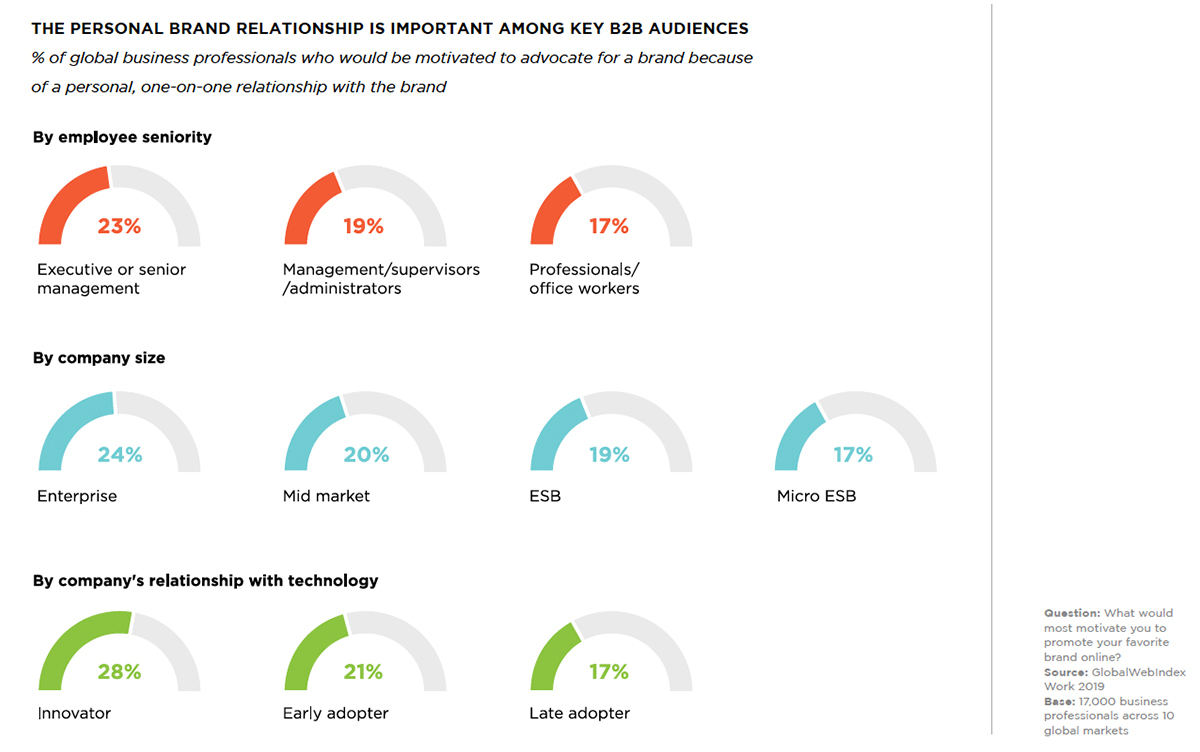
Key Takeaways
- Roll ‘em. Let salespeople host video demos, in place of slideshows and manuals. Raise your video production budget for high-def equipment, and taking a chance going live on social media.
- Appeal to the human side. Think of it as a partnership, not a sale. Lead with empathy and loyalty.
- Dial back product promotions. Sounds counterintuitive, but that level of selflessness allows for a more authentic connection.
Next Steps for Human Experience
Marketing at all levels and in all spaces has been put on notice.
Stay-at-home orders meant stay-online realities, which many consumers grew weary of. A near universal desire to bring back the human side of humanity drives not only what we do socially, but also how we do business, buy goods, and patronize.
Brands must tie in the culture they’re in – as a community, region, state, and nation. “All of those things play into how we’re going to go through all of this,” Kovan said. “That’s something we need to be mindful of moving forward.”
- Embrace the little details of the big picture. Allow people the chance to live out their story, and remember that unique details make up the big picture.
- Localize. The human experience has subtle differences in mature and emerging markets. But it all becomes personal marketing. Culture influences behavior and motivations, Kovan said. “And behavior and motivation shapes culture. Where is the pandemic shaping our culture long term?”
- Let technology lead the way. It’s the tool, not the answer. Technology is powerful – especially when it fosters human experiences over digital ones.
Reacting to the moment in 2020 has short-term implications. Building a strategy both future-proof and responsible to the greater community starts with creating the human experience, not a customer experience.
“We want our clients to know we understand business,” Kovan said. “Brands have to open themselves up and be vulnerable. Be willing to change their approach, trust data, learn how they can be more effective. The same old same old is not going to work anymore.”
“The Brandon Agency offers clients a benefit: We have business minds, and creative hearts.”
The Brandon Agency has taken a human experience approach with an array of businesses in various stages of development. Using market insight and signature innovation, TBA is proud to have partnered with remarkable brands. The Brandon Agency is ready to partner with you. Contact us for a consultation.
Sources: GlobalWebIndex
